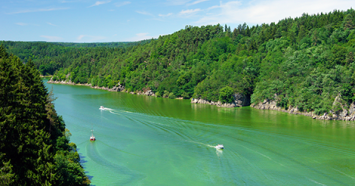
It’s a hot summer day, your dog is bouncing around the house with energy, so you think, “why not go to the beach?” This has been a popular mentality across the nation as summer temperatures rise. According to Embrace’s survey of pet owners, nearly 50% of dogs like to swim and 46% of dog owners have taken their pups to the beach. What many pet owners don’t know is the lurking danger of fast-growing blue-green algae blooms.
What is blue-green algae?
Blue-green algae is a type of cyanobacteria. While algae naturally grows in rivers, lakes, and ponds, an increase is hot weather can encourage “blooms,” or excess growth of algae. Blue-green algae thrives in hot, dry conditions in bodies of water that have been stagnant for long periods. There is an uptick of blooms come late summer and into early fall due to the excessive rain fall and sporadic temperatures.
While blue-green algae can cause illness in humans, it is extremely toxic to animals.
Why is blue-green algae toxic?
The algae blooms secrete a neurotoxin that can damage an animal’s nervous system and liver. The CDC has recommended keeping out of the water until these conditions pass. Dogs who ingest water contaminated with blue-green algae will be immediately affected.
Keeping your pet completely out of the water is the best option as many dogs lick their coats post-swim which can lead to toxicity. The toxic properties of the algae are fast-acting. Various pet owners have reported their animals becoming sick within an hour of leaving the water. Many dogs who had been exposed to the blue-green algae became very ill and later died.
What are the symptoms of blue-green algae exposure?
The symptoms are fast-appearing and should not be taken lightly. You should seek immediate medical attention if your animal begins displaying any of the following:
Seizure or collapse
Disorientation
Excessive drooling
Difficulty breathing
Diarrhea
Loss of bodily movement
While the toxins are more often fatal in animals, humans can experience rashes, nausea, stomach pains, and fever if exposed to the algae.
How You Can Prevent Exposure
In order to prevent illness from blue-green algae exposure, Embrace recommends you keep your animals away from bodies of water during peak algae bloom months (late summer into early fall).
If you have any bodies of water that are accessible to your pets, confirm that they are not infested with blue-green algae. If algae blooms are present, limit access. Additionally, keep fresh water outside for any outdoor pets to eliminate any threat of ingesting contaminated water from a nearby pond.
Finally, if you have found yourself in a lake or pond recently, give your pet a nice, soapy bath to ensure their coat is clean. Keep a close eye on your animal for any signs of toxicity. If your pet begins to show symptoms, get them to a veterinary hospital immediately.
If limited beach access is putting a damper to your summer plans, check out Embrace’s summer bucket list for more paw-tastic, and safe, activity options.